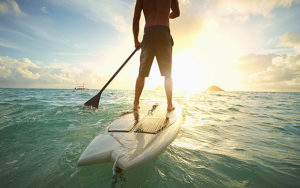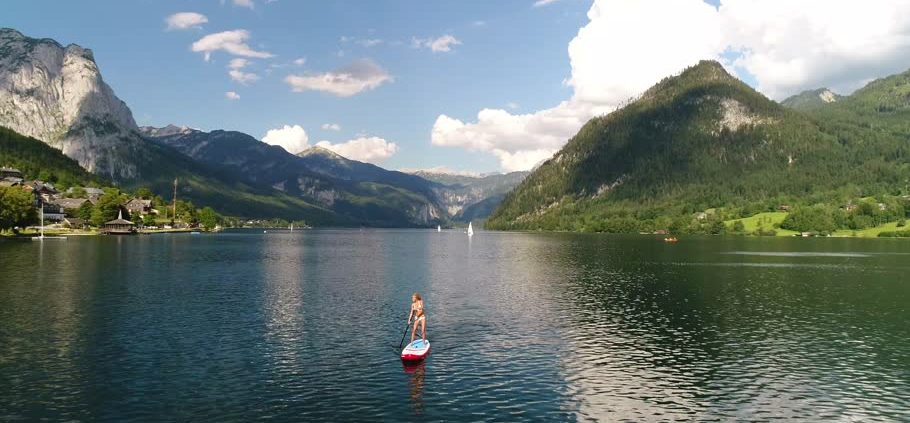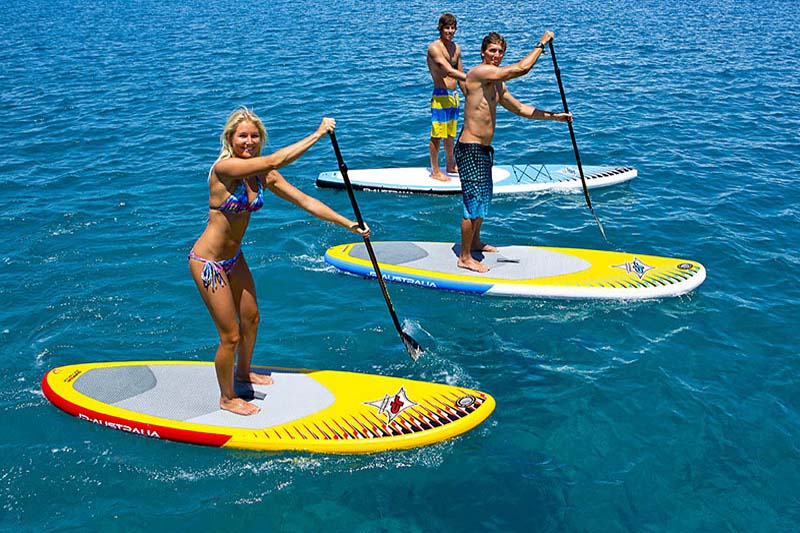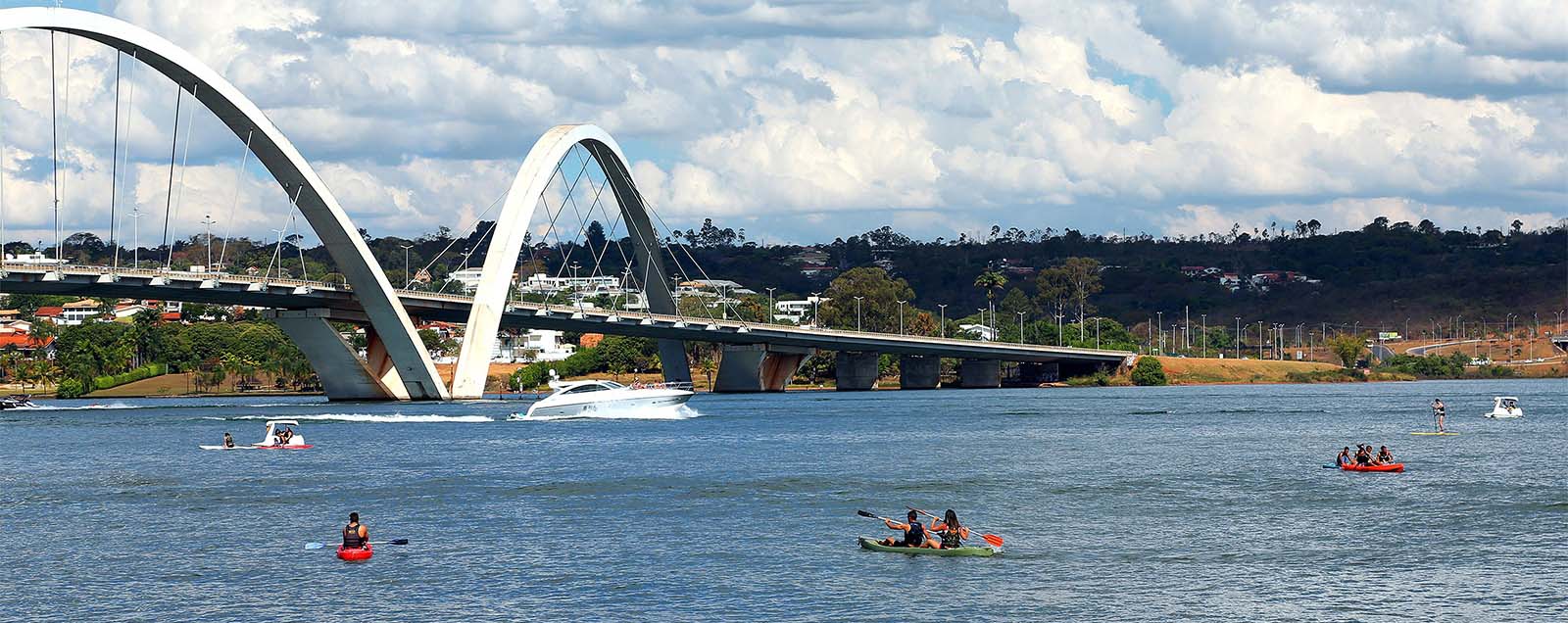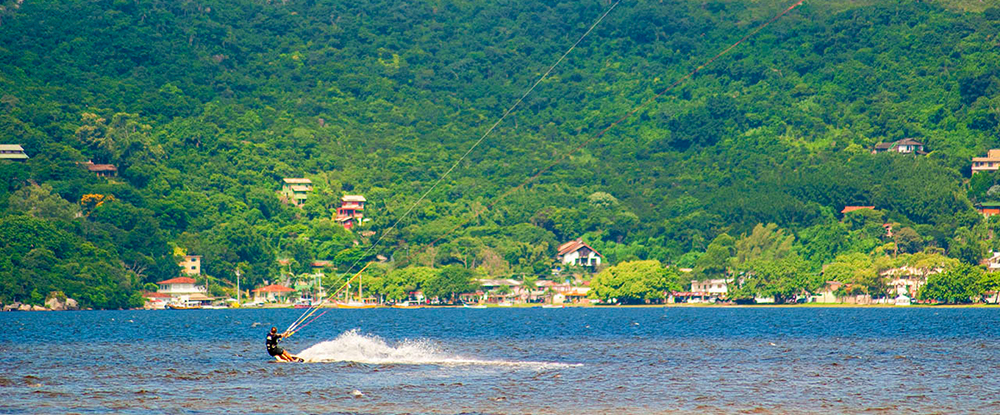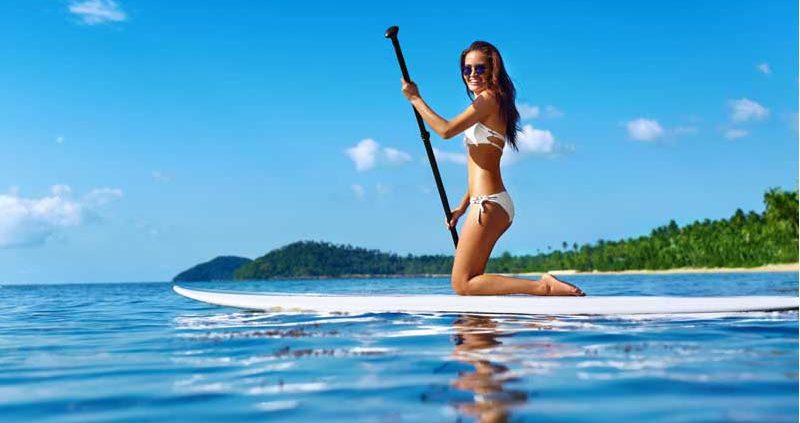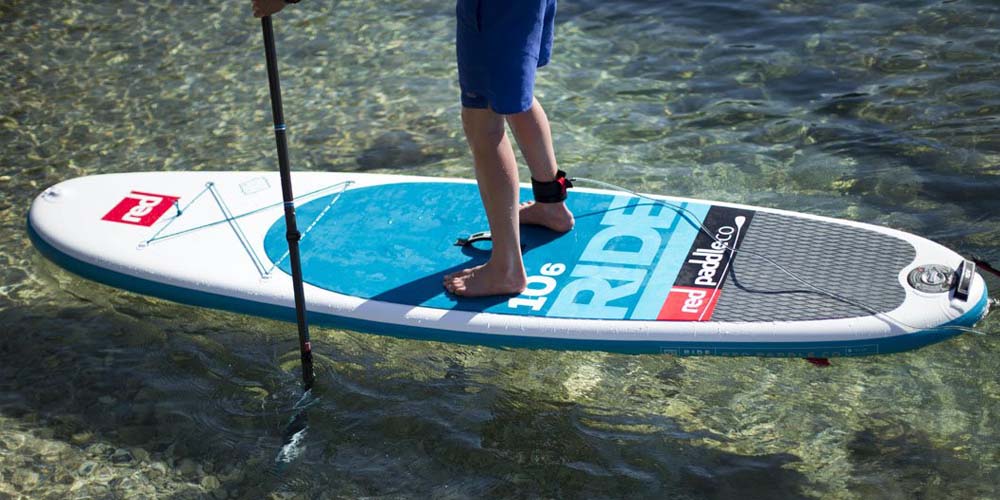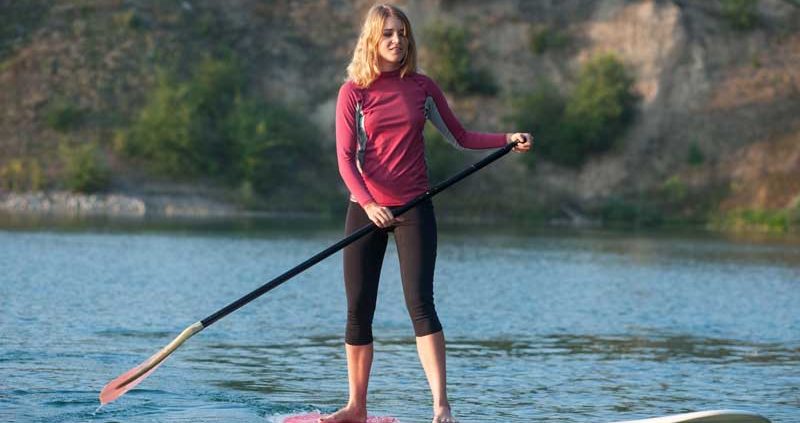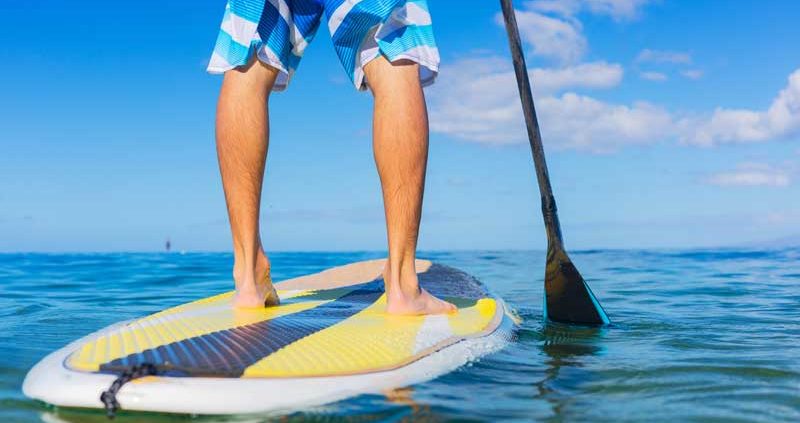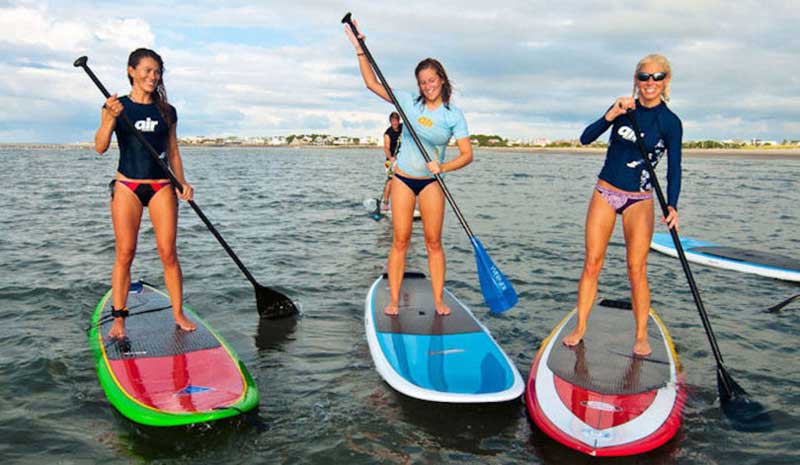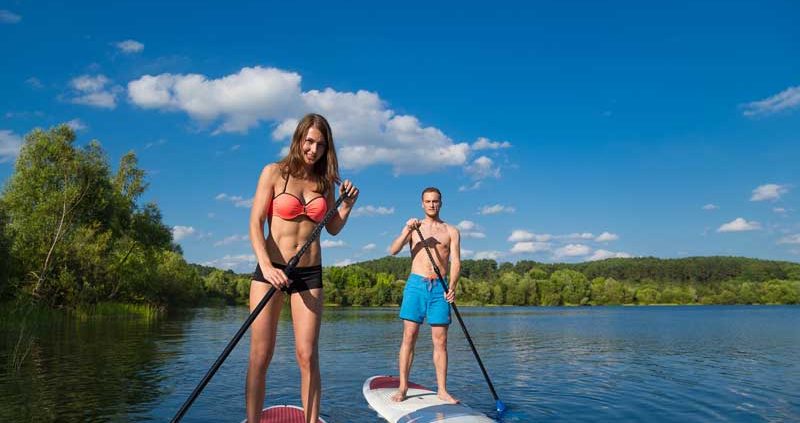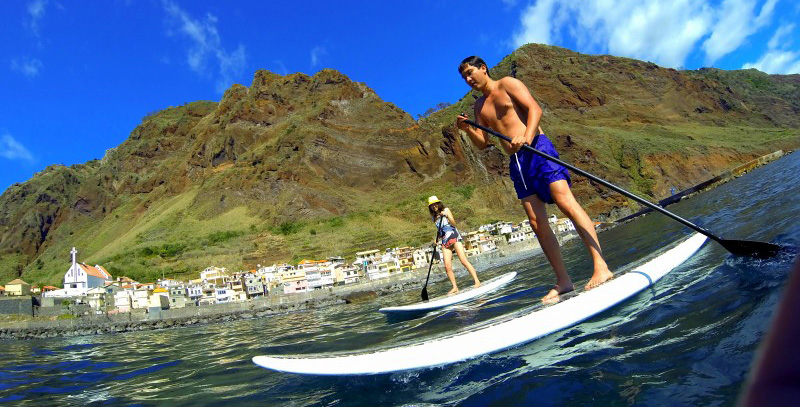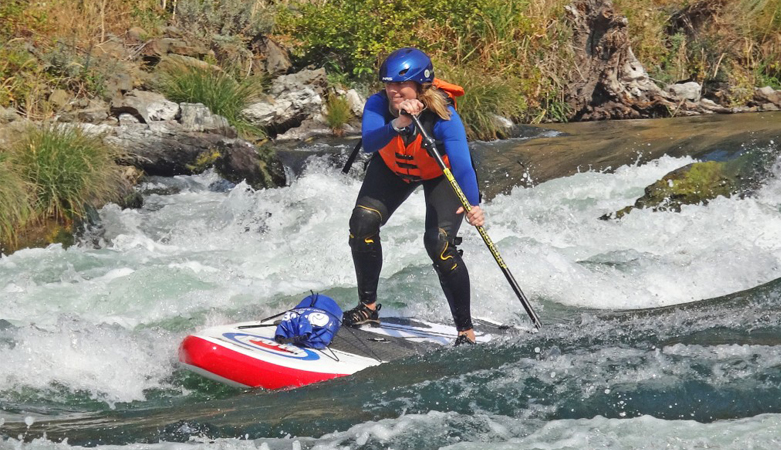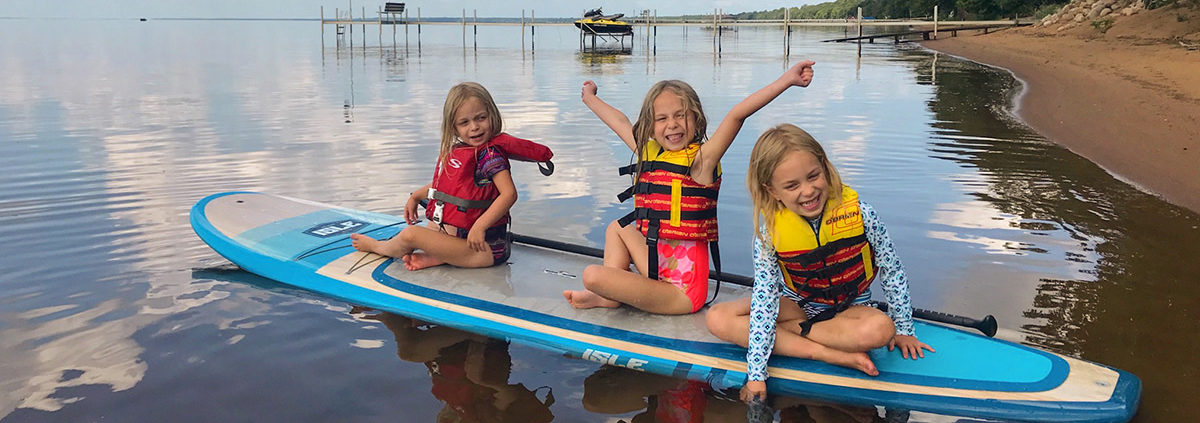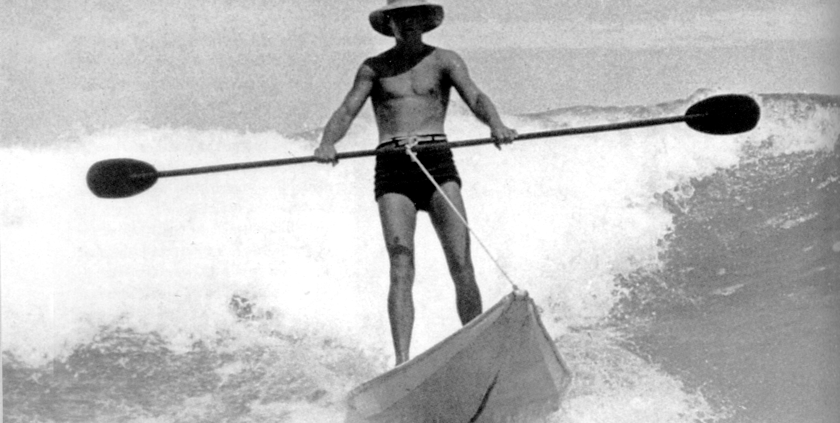The Top 8 Reasons You Should Try Stand-up Paddle Boarding
/0 Comments/in Stand Up Paddling Advantages, Stand Up Paddling News, Stand Up Paddling Tips/by adminThere’s nothing like stand-up paddle boarding, and if you’ve never tried it, then you’re missing out. We can list hundreds of reasons why you should give it a try, but we’d be here all day. However, we’re going to provide you with eight reasons why you should try stand-up paddle boarding. These reasons include:
1. Just About Anyone Can Do It
First and foremost, just about anyone can learn SUP, short for stand-up paddle boarding. It doesn’t matter if you’re completely new to SUP or how old you are, the chances are you will be able to do it. Many people find they are standing up within the first hour of learning how to do it, sometimes in much less time than that.
2. It’s A Workout
With SUP, you use your arms to paddle and you move around quite a bit throughout your duration on the water. Also, SUP may help improve your balance and core because you use core when you do it, but you have to really focus on keeping balanced. If you have bad balance, then start doing SUP on a regular basis and you might see an improvement within a few short weeks.
3. Explore Places
Paddle boards allow you to explore places. For example, you can get on a paddle board and explore narrow lagoons, hidden caves and things of that nature. You can go many places where boats can’t when you use a paddle board.
4. Not A Lot Of Equipment Is Needed
Another reason why you should give SUP a try is you actually don’t need a whole lot of equipment. Basically, you’re good to go if you have a stand-up paddle board and a paddle. Also, you might want to buy a leash to attach to the board, just so it doesn’t get away from you in the event you fall off of it. You can even go to your local surf store and ask them about SUP rentals and SUP lessons.
5. Do Different Things On It
Obviously, you can stand up on the board and guide it through the water. However, there are other things you can do with a stand-up paddle board, such as yoga or meditation, bringing out lunch with you and eating it while you sit on the board. These are only a few of the many examples of what you can do with stand-up paddle boarding.
6. It Is Safe
Unlike surfing, SUP has an extremely low risk of injury. It is extremely safe to do, and reading instructions and implementing basic safety tips should be sufficient enough.
Health Benefits of Stand Up Paddling
If possible, you can book a SUP guide to teach you how to do it and what to do to be safe. Although using a guide or instructor is recommended, you should be fine if you choose not to.
7. SUP Is Relaxing
SUP is actually relaxing, especially if you do it somewhere that doesn’t have many people. Even if there are quite a few people, you’ll still find it relaxing. There’s something about being out on the water with the sun glistening down on us that makes people feel at ease, calm and just relaxed. If you’re looking for a way to unwind and clear your mind, then give SUP a try.
8. It’s Fun
This is probably obvious, but stand-up paddle boarding is a lot of fun. Even if you’re a complete beginner, you will enjoy learning how to do it. Once you become an expert, you will still have a lot of fun.
Are you looking to try something different and something that is extremely fun to do? If so, then you should try stand-up paddle boarding. Remember, the above are only eight of the many reasons why you should try stand-up paddle boarding.
Stand Up Paddling in Brazil
/0 Comments/in Stand Up Paddling News, Stand Up Paddling Tips/by adminStand Up Paddling in Brazil
Stand Up Paddling (SUPing) is a great water sport, accessible to a wide variety of people – from kids to adults. And when you can combine a bit of exercise with stunning scenery, life is good. The amazing natural beauty of Brazil is perfect for the sport. There’s a variety of places to choose from including tranquil lakes and inviting calm waves of the open sea. Brazil is an amazing place for an exotic getaway and SUPing is a great way to make the most of the balmy outdoors of this fascinating country.
Lago Paranoá, Brasília
This stunning artificial lake located in the capital of Brazil is a paradise for water sport lovers. Jump on your board and appreciate the beauty of the surrounding area. And keep your camera close by for a postcard moment while rowing towards the formidable JK Bridge.
Lago Paranoá, Brasília
The lake was created during the city construction, the Paranoá River was dammed to produce it. It is 80 km (50 mi) in circumference. It’s a little piece of nature tucked away in the city. On the shores you will find the suburbs of Lago Sul and Lago Norte, the Brasília University, restaurants, sports clubs, the Olympic Center, consulates and embassies, and the Palácio da Alvorada. You can also paddle past the official home of the Brazilian president.
Forno Beach, Arraial do Cabo
Stare out over the pristine waters with its shades of blue and green, it’s been called one of the most beautiful beaches in Arraial do Cabo. But beware, its beauty draws big crowds, it is especially busy in the summer. Don’t be fooled by the warm weather, the water will still be icy cold.
Forno Beach, Arraial do Cabo
The small cove on the Rio de Janeiro coastline is a great spot to test out your SUPing skills. Practice to your hearts content in the inspiring surroundings. Afterwards you can reward yourself with scrumptious seafood at the floating beach restaurant.
Conceição Lagoon, Florianópolis
When you are visiting the island, you must spend some time at this amazing lagoon. If you don’t feel quite ready to paddle on the open waters of the sea, this is the ideal alternative for you. Plan your paddling session towards the end of the day and enjoy an unforgettable sunset.
Conceição Lagoon, Florianópolis
The island offers you the best of both worlds, if you feel ready to move over to the sea, you can travel to the edge of the island to the beautiful beaches. Beware that the popular tourist destination becomes extra busy in the Brazilian summer vacation (January and February)
Poço Encantado Waterfall, Chapada dos Veadeiros
The mesmerizing waterfall is tucked away in a secluded spot in the Poco Encantado national park, a protected area. Cool down in the cold waterfall waters before jumping back on your board for a paddle in the pool with friendly small fish swimming under you. Relax on the pristine fine white sand of the small beach afterwards. Explore the jungle-like area surrounding the waterfall. The rock formations found in the park are some of the oldest in the world. After your spectacular SUPing session, stop at the little restaurant near the waterfall for a simplistic roasted fish meal.
Travelling tip: book a stay in a pousada
In Brazil you don’t have to stay in a hotel, you can stay in a pousada. The Portuguese word means “inn” and it’s very different to a traditional hotel. If you want to translate it closer to English, you could call it a “bed and breakfast” or “guesthouse”.
These accommodation hubs offer you a much more intimate accommodation experience. Usually they only have about 20 rooms, some even as small as less than 10 rooms. A pousada is run independently, typically managed by a family. The type of pousada you can stay in range from a little fancy boutique hotel, to an experience closer to AirBnB with a spare room or section of a house converted into tourist accommodation.
Madeiro Beach, Tibau do Sul
This stunning protected beach is one of the wildest areas of the region. You can only access it by foot. A tropical forest leads onto the secluded spot, with its residents including turtles and dolphins. The dolphins are regular visitors to the area and can be spotted almost every day. What better way to create a memorable Brazilian SUP experience, than to be joined by a pod of dolphins. With the area being part of a national preservation project, you are guaranteed an amazing rugged nature-filled experience here.
Lençóis Maranhenses National Park, Maranhão
The words “sand dunes” and “stand up paddling” don’t often meet each other in the same sentence. But in this national park the rainy season creates a unique phenomena. The valleys between the dunes are filled with freshwater, creating seasonal lagoons.
Lençóis Maranhenses National Park, Maranhão
The sturdy rock located beneath the sand prevents the water from draining. This desert was declared a protected area in 1981. It is 383,000-acre (155,000 ha) in total, including 70 km (43 mi) of coastline. It has become a popular spot for ecotourists, with four endangered species calling it home.
A stay in an Atins pousada is highly recommended when you visit during the rainy season. The town
is located conveniently close to travel in and out of the national park.
Negro River, Manaus
Experience a truly amazing natural phenomena called the “Meeting of the Waters.” The dark Negro
River mingles with the brown Solimões River to create a striking combination that forms the Amazon River. Paddle on the strange river wrapped by the Amazon Rainforest.
Amazon and Rio Negro Rivers Meeting of the Waters in Brazil
Paddling the igapós, Amazon Rainforest vegetation flooded by the river, is a once in a lifetime experience. You will feel truly part of the lush forest surrounding you. The Negro river is the gateway to the expansive state of Amazonas.
Concha Beach, Itacaré
It’s an easy ten-minute stroll to the beach from the Pituba city center. It’s a perfect spot for anyone wanting to get better acquainted with SUPing. Make your way through the coconut trees to the beautiful tranquil sea. Compared to the other nearby beaches, the sea is much calmer here. Start closer to the lighthouse to access the shallow water. It’s an ideal spot for SUP practice sessions. Once you’ve tired yourself out, pop in at one of the close by beach restaurants for a refreshing cocktail.
A Look at the Top 6 Stand Up Paddle Boards for Rivers
/0 Comments/in Stand Up Paddling Advantages, Stand Up Paddling News, Stand Up Paddling Tips/by adminA Look at the Top 6 Stand Up Paddle Boards for Rivers
Stand up paddle boarding is a fantastic way to enjoy nature and get in a workout at the same time. In this guide, we are going to highlight 6 of the best stand up paddle boards you can get right now, so you can enjoy Mother Nature tomorrow.
If you’re an outdoor enthusiast, no doubt you’ve noticed how popular paddleboarding has become in recent years. In fact, the sport has even taken off in the UK and other areas not typically known for a particularly widespread interest in water sports.
The transportable, inflatable technology of paddle boards is one of the things about the athletic trend that people love most. Plus, it’s a suitable sport for peaceful lakes, ocean surfs, and every body of water in between. But, certain stand-up paddle boards may be best, depending on where you intend to use yours the most.
In this post, we’re taking a look at the top paddle boards for rivers.
If you’re considering paddle boarding down rivers, find out which boards are best for you!
Our Top 6 Picks for Stand Up Paddle Boards for Rivers
Are you ready to take your paddle boarding passion to the river?
Take a look at our list below of boards that are designed to take on your favorite Utah river destinations.
1. Best Beginning Paddle Board for Rivers: ISLE Versa Epoxy Standup Paddle Board
This lightweight, versatile, epoxy stand up board is an excellent choice for beginners just starting to navigate rivers with relatively small waves.
At 10.5″ long, a width of 32″ and a volume of 175 liters, the ISLE Versa’s thermal construction makes it a great board for those wishing to transition from one skill level to another.
Plus, the center fin and carrying handle mean you won’t have trouble transporting your board should you have to travel to your river destination.
When you are ready for more serious paddling, you won’t have to exchange your board. Although it’s listed here as a top choice beginner board, it’s equally matched for intermediate boarders as well.
2. Best Buy Paddle Board: The Red Paddle Co. 10’8
The Red Paddle Company’s board measures 4.7″ thick, 34″ wide and packs 296 liters of volume which helps it to maintain superb tracking and balance in the water. It’s also another great choice for beginners due to its’ ease of handling. But, it’s suitable for intermediate and advanced riders too.
A front-loading cargo kit carries all of your paddling gear but doesn’t compromise its’ performance, surprisingly. The kit and the wheeled backpack add to the board’s portability and make it an especially good pick for longer river tours.
You don’t have to spend much time pumping this board up to get a firm ride, even on choppier rivers. And, it’s a good choice for boarders who are transitioning to a more advanced skill level.
No wonder it was voted the Indy Best Buy board by UK’s Independent News.
3. Most Versatile Paddle Board: Ocean Kayak Nalu Hybrid Stand-Up-Sit-On-Top Paddleboard
This board is great for calm lakes or rivers, but does well on small waves, too.
The thing that we really love about the Ocean Kayal Nalu Hybrid is that riders can choose to use as either a traditional stand-up paddle board, or they can sit on top if preferred. This feature earns it the top spot for versatility.
Ocean Kayak Nalu-Stand Up Paddle Boarding
It has built-in bungee cords, so you get extra storage room for your gear in the back. And, it’s bow is designed to cut through waves, so you can take it on peaceful or more moderately rough river rides.
It measures 11 feet long and has a flat bottom which makes for a comfortable standing position.
4. Best Looking Board: CRAZZIE Stand Up Paddle Board in Real Bamboo Wood
Obviously, when you take this CRAZZIE Bamboo Wood Paddle Board down any river, you’re going to turn heads. This beautiful board measures 10.5 feet long and 33 inches wide and weighs about 27 pounds.
Its lightweight wood makes for a stiff, but easy to handle ride for beginner to intermediate river waves.
The board also comes in a longer version, which tends to be best for Yoga enthusiasts. If you’re paddling down a river, you probably will want to stick to the shorter board, unless you’re not expecting to encounter any potentially rough waves.
5. Best Paddle Board for Kids: 8’4 BIC SPORT Dura-Tec Original Paddle Board
The 8’4 BIC SPORT Dura-Tec Paddle Board is a great choice for kids.
Not only does it come in a variety of cool colors, it has extra safety features such as an integrated deck pad that provides a more stable ride. In addition, its’ features also include a 10″ dolphin fin, plus combined leash plug and a deck rig anchor.
8’4 BIC SPORT Dura-Tec Original Paddle Board
Kids will feel secure on this board, even if they just starting out. And, parents will breathe a little easier knowing they’ve chosen a board with added security features for their little paddlers.
6. Best All Around River Paddle Board: The Aleka by Surftech Bark
Surftech Bark’s Aleka Paddle Board is a perfect match for all types of rivers and practically any body of water.
Its 29″ width makes it quick and easy to zip across river channels. Although, it’s probably best suited for intermediate or advanced skill levels.
It also has unmatched durability, is lightweight, and combines the right amount of steadiness and glide to make your ride as enjoyable as possible.
It also comes in two different sizes, depending on your preference and needs. The shorter version cuts the cost by over a hundred bucks, and can still accommodate most river riders.
Want to Try Before You Buy?
If you are new to paddle surfing or want to try out a couple of great boards, we can help.
We rent a variety of stand up paddle boards along the banks of some of Utah’s most vibrant rivers, such as Highland Pond, Utah Lake, and the Jordanelle Reservoir.
Contact us today to plan your next stand up paddling river adventure!
Exploring Utah On A Stand Up Paddle Board: Utah’s Best Places to Stand Up Paddle
/0 Comments/in Stand Up Paddling News, Stand Up Paddling Tips/by adminExploring Utah On A Stand Up Paddle Board: Utah’s Best Places to Stand Up Paddle
If you plan on visiting Utah or if you’re fortunate enough to live here, you’ll be happy to know there are some fantastic places to take your stand up paddle board and enjoy the scenery. Here’s a look at just a small selection of some of our favorite SUP spots in the state of Utah.
Do you want to try something new before the summer is over? You may have spent the past few months fishing, jet skiing, and kayaking. But what if I told you there is another water sport you could learn?
Riding a stand-up paddle board has become increasingly popular for many reasons. It gives you the chance to relax on the water and enjoy mother nature. Don’t think that because it’s relaxing you won’t get any exercise too! There are many health benefits to stand up paddle boarding, including increasing strength, reducing stress, and improving endurance.
So, now that you’ve found your new favorite water sport, you need to find the perfect location to begin. If you live in Utah (or are planning a trip there soon), consider yourself lucky! There are tons of beautiful locations to SUP.
Do you want to know where they are? Keep reading to discover the best places to stand up paddle board in Utah.
Utah Lake
Utah Lake is a great place to hit when you want to learn how to stand up paddleboard. It’s the largest freshwater lake in Utah, so you’ll have plenty of room to roam without worrying about bumping into a fellow paddleboarder.
Utah Lake
The lake is also very easy to access with several different entry points, so you won’t have to worry about getting lost trying to find the lake. If you want to turn this into an overnight or weekend trip, Utah Lake also has some amazing fishing, especially for panfish, catfish, walleye, and white bass.
Jordanelle Reservoir
Have you been stand up paddle boarding before? You know that it doesn’t take long to get used to it. If you want a little more of a challenge, the Jordanelle Reservoir is one of the best places to paddleboard in Utah.
The reservoir has a wake and a no wake zone. If you want something harder, the wake zone will have some residual waves from boats and jet skis. If you’re still learning, or if you’re with someone who is new to SUP, the no wake zone is perfect. The water is very calm and great to practice balancing before moving on to the wake zone.
Highland Glen Park
Do you get jealous hearing your friends talk about their local beaches while you live in a landlocked state? While we can’t push Utah to the coastline, that doesn’t mean you can’t enjoy the beach.
Highland Glen Park has a sandy beach and a beach volleyball court, so you can get the whole experience. There is also a playground, which makes it a great family destination.
The water is calm and small enough that you can swim to shore if needed, making it a good place to learn how to SUP. When you get out of the water, enjoy a picnic in one of the many shaded pavilions or grassy fields.
Tibble Fork Reservoir
Highland Glen Park isn’t the only place you’ll find a sandy beach. Tibble Fork Reservoir is a stunning place to stand up paddleboard. It has breathtaking blue water, scenic views, and a sandy beach.
It’s a great place for beginners because it’s a wake-free zone, ensuring the waters stay calm. There is also a floating dock to help you get on your paddleboard – just remember to follow SUP tips and start on your knees!
If you want to spend more than a day here, you’ll have no problem finding things to do. There are several hiking trails and campgrounds, as well as amazing fishing.
Lower Provo River
Are you a thrill-seeker to the core? You may think that paddle boarding sounds a little too boring for your blood, but that doesn’t have to be true! Lower Provo River is one of the best places to paddleboard in Utah.
The entire river takes about 90 minutes to paddleboard, and there are many areas with light rapids. This may not seem too adventurous, but the smallest rapids can make staying on your paddleboard a challenge. Make sure you follow the golden rules of stand up paddle boarding to stay safe.
Perhaps the best part of paddleboarding down the Lower Provo River is the change of scenery you’ll get to experience. You’re constantly moving forward instead of paddling around in the same lake, so keep your eyes peeled.
Silver Lake Flat Reservoir
Do you want to enjoy the beauty of nature without hoards of people surrounding you? We have the perfect place for you!
Silver Lake Flat Reservoir is very secluded, so you won’t have to worry about loud noises or crowds. You’ll get to enjoy the peace and quiet as well as the beautiful scenery. If you want to spend a weekend away, there are also stunning hiking trails here, so you’ll never get bored.
Mirror Lake
Day trips and weekend getaways are perfect to slip away from your busy life. But, if you have more than a day or two at your disposal, Mirror Lake can make a great vacation.
It’s one of the largest lakes in Utah and offers plenty of things to do, including camping, hiking, fishing, canoeing, and (of course) paddleboarding. If you want to stand up paddle board somewhere new halfway through your trip, there are many other lakes within a hiking distance.
The best part is that Mirror Lake has a higher elevation, so it’s cooler in the summer. Say goodbye to scorching hot summers and enjoy the comfortable temperatures on the mountain.
Where to Stand Up Paddle Board in Utah
If you want to try your hand at paddleboarding, you may not know where to go first! Utah is full of pristine lakes that are perfect for beginners, as well as some places fit for experts. Follow our guide to find the best places to stand up paddle board in Utah.
Are you ready to try stand up paddleboarding? Contact us today to learn about rentals and lessons in Utah.
A Beginners Guide for Improving Your SUP Paddle Technique
/0 Comments/in Stand Up Paddling News, Stand Up Paddling Tips/by adminYour experience paddle boarding is only going to be as good as your SUP paddle technique. If you’re having a hard time paddling while on your SUP, you’ll want to check out this article because we’ll give you a few tips and pointers on how to improve your SUP paddle technique!
Stand up paddleboarding is one of the fastest growing outdoor recreation activities. Why?
Because it’s a full body workout that also reduces stress. Oh, and it’s super fun, too. Sign us up.
Newbies and seasoned SUP-pers alike can use a brush up on SUP paddle technique. Keep reading to learn everything you need to know about how to get the most out of your time on the water.
Get the Right Size Paddle
First things first: you have to gear up right if you want to get anywhere on your paddleboard.
Your paddle length is crucial for a successful SUP session. You should choose your paddle length according to your height– your torso height, that is.
Here’s how to measure your torso. Sit up very straight in a chair, and have someone else measure the length between the chair and your nose. That’s your torso length.
Once you’ve got that number in inches, here’s how you use it to determine the right paddle length for you:
- A 22″ torso needs a 180cm long paddle.
- For every 2 extra inches of torso length, add 10-15 cm of paddle length.
- Example: if your torso is 26″ long, your paddle should be about 200-210cm long.
After you determine your paddle length, make sure to account for the width of your board, too. SUP boards vary in size. Wider boards need longer paddles to be sure you’re paddling with the most power.
Stay Loose, but Straight
The two most important things for maximizing strength: your posture and paddle grip.
When it comes to your grip, make sure you’re not holding the paddle too tight. This will force you to work your arms harder than necessary. It’ll also impede your ability to reach the paddle out as far as needed.
A good rule of thumb is to make an O shape with your hands so the paddle can slide with ease in and out of the water. Think of your grip like the rung that a canoe paddle goes through. It’s tight enough to hold the paddle in place without being restrictive.
When it comes to your posture, it’s essential that you keep your back as straight as possible to avoid injury. Your back shouldn’t be doing the bending here, your hips and legs should. Keep your knees bent so your legs are springy, and able to rotate your body as needed.
How to Paddle Board the Right Way
Proper paddling technique is the key to a good workout. Make sure you follow these steps to get the stroke right every time.
Reach Far
As you’re reaching the paddle out at the beginning of the stroke, make sure to reach as far as possible. The farther you reach, the more momentum you’ll create for yourself in the stroke.
If your board is rather wide, this is where a longer paddle will come in handy. It can be tough to reach far enough if your board is taking up prime real estate in the water beside you.
Catch Clean
As your paddle meets the water, make sure to dig deep. Immerse the entire paddle into the water. This’ll allow you to gain the most traction possible during the backstroke.
You’re losing momentum with every inch of the paddle that’s not submerged. It’ll make you have to work harder and make you move slower.
Stay Strong
The backstroke itself is where you’ll need to use your power. Engage your core so the bulk of that strength comes from your legs and lower back, rather than your arms. Your arms should only guide the paddle where it needs to go.
Make sure to keep your back straight as you rotate from side to side. Try to rotate from your hips only, and plant your feet on the board to help work your core.
Prepare for Another
Your release should take place at your feet, and not further back. If you’re releasing much further back, you’re not reaching far enough at the beginning.
Paddle Boarding Basics Tutorial
As you pull your paddle out of the water, keep it as close to the surface as possible. This’ll prepare you for your next stroke. It also won’t add extra stress to your arms to lift the paddle higher than it needs to be.
One great way to learn from the best is to watch professional paddlers on TV. Check out your local cable listings or DStv guide for SUP event screenings and make sure your DStv installation is active and working.
Common Mistakes
That’s the ideal way to pull off one SUP stroke. Here are some of the most common, rookie mistakes that you should try to avoid.
First, using your arms instead of your core to power your strokes. This’ll cause burnout super fast, and won’t give you the full body workout you could be getting. Try to use your arms only to guide the paddle where it needs to be.
The second mistake is keeping your arms too close together. This makes for sloppy paddle technique since you’re sacrificing control over the paddle. Spread your arms out if your paddle feels too wobbly.
The third mistake is looking down at your board or the water instead of out ahead of you. You’re stable, we promise. Keep your eyes on your destination, and the board will follow.
The fourth mistake is not reaching far enough at the beginning of your stroke. This won’t allow you to maximize the force of the stroke, making for a powerful pull forward. Reach, reach, reach!
The last most common mistake is not submerging your paddle deep enough during your catch. Again, this is a missed opportunity for more power in your stroke. Make sure to cover the entire paddle head with water.
Master Your SUP Paddle Technique
Now that you’ve learned how to talk the talk, it’s time to walk the walk and get on your new paddleboard! If you’re a beginner, don’t feel intimidated. If you’re an expert, you can apply these tips to your existing SUP practice.
If you’re in Utah, there are plenty of gorgeous places for you to practice the art of SUP paddle technique.
Do you have questions about SUP paddling, SUP paddling technique, or SUP boards? Get in touch— we love to talk shop!
Exploring 5 of America’s Most Beautiful Places to Go Paddle Boarding
/0 Comments/in Stand Up Paddling News, Stand Up Paddling Tips/by adminThe United States is full of beautiful places that’ll make you take a step back and appreciate life. If you love paddle boarding and you want to see some of the beauty in this country, then you’ve got to check out these 5 most beautiful places to go paddle boarding!
Paddle boarding is a fantastic way to get in some “you” time, hang out with friends or enjoy all the beauty water and land offer.
Whether you’re an avid paddle boarder or someone new to the sport, the United States offers so many spectacular locations where paddle boarding is the perfect way to spend your day. But which are the best?
It’s time to find out.
Do you want to see Earth’s beauty from your board and experience everything an area has to offer? If so, check out our list of the top five places to go paddle boarding in the US.
Why Try It?
If you are not the athletic type and you’re afraid you’ll fall into the cold water, rest easy. Anyone can learn stand-up paddle boarding in a matter of an hour, and you can always paddle while sitting.
Doing it is a relaxing way to enjoy the water, explore and be one with nature. That’s why it’s become so popular.
Believe it or not, you’ll exercise all the muscles in your body without realizing it.
The Best 5 Places to Go Paddle Boarding in the US
From the tropical island of Hawaii to the cold waters of Alaska, our list has a variety of geographical locations and prospects that are sure to entice paddle boarders of all levels.
1. Kauai, Hawaii
Hanalei River is the ideal matchup for any stand-up paddle board (SUP) beginners. The river is gentle and smooth year round, offering still waters from which viewers can enjoy all of Hawaii’s beautiful sights.
The river begins on the slopes of Mount Waialeale, ending in the crescent-shaped Hanalei Bay. The winding waterway flows along Hanalei National Wildlife Refuge, where visitors are not allowed to enter.
The Refuge is a sanctuary for several endangered waterbirds, such as the Hawaiian stilt and the Hawaiian goose. Consequently, you’ll be able to enjoy the preserved nature and wildlife the Refuge offers.
Paddle Boarding Hawaii.
Pass under the Hanalei Bridge, the only way to enter Hanalei Town or the northernmost reaches of Kauai. If you happen to be in Hawaii, this is one of the most relaxing paddle board experiences you can find.
When you’re done, head out to the ocean for some amazing views of underwater life and coral.
2. Mirror Lake, Utah
So named because of the water that reflects the Uinta Mountains in which it rests, Mirror Lake sits at 10,400 feet.
The area offers tons of hiking trails that connect to smaller lakes, such as Bonnie Lake, Scudder Lake, and Natural Basin. All boarders have to do is take an inflatable SUP to enjoy all the views Mirror Lake and the surrounding area have to offer.
The lake has several advantages. Firstly, during the sweltering summer months, the weather is cooler. Secondly, motored water vehicles aren’t allowed, so you won’t have to listen to the annoying hum of engines.
Finally, the sheer abundance of activities the Mirror Lake Highway offers is extraordinary. Viewers can travel to the Fairy Forest, hike the trails and stop for a bite to eat at local diners, such as Hi-Mountain Drug and the Train Place.
Your adventures will reveal breathtaking views of Tenaya Canyon, Mount Natkins, Washington Column and more.
3. Alaska
Do you want to see whales? Seals? Glaciers?
Then it’s time to take your paddle boarding to Alaska. It may sound cold, but boarders usually suit up with proper attire to ensure they aren’t chilly. Many inland lakes won’t even require the extra layers during the summer.
Twin Lakes lies in Lake Clark National Park, which is rife with recreational activities. Paddle boarders can watch brown bears catch salmon, fish in their spare time, and check out volcanoes and ice-capped mountains.
Eklutna, which is 22 miles from Anchorage, also offers its fair share to paddle boarders. It’s a glacial lake surrounded by paths and campsites. Stay for a week in the summer to explore the various plant life via horseback.
Kenai Lake is another popular destination for recreational activities. Sit or stand on your paddle board to take in everything the 5,590-hectare lake has to offer. Then hightail it to the four trails that lead to different destinations.
This state may not seem like a paddle board destination, but you can’t go wrong with any of its lakes and rivers.
4. Dewey Beach, Delaware
If you want a bit of everything, Dewey Beach offers it. Paddle board the waters by day to watch dolphins playing in the waters along the Atlantic coast or try your hand at parasailing. When you’re finished, stop along the beach for some shopping and souvenirs.
Explore the coastal salt marshes when you’re tired, then get back on the water to make the Taco Toss happy hour at The Lighthouse. When the sun falls and your paddle board retires for the evening, enjoy the bayside nightclubs.
Dewey Beach also offers festivals teaming with merriment for holidays.
5. Lake Tahoe, California
Ready for superbly clear waters? It’s time to visit Lake Tahoe, one of the largest alpine lakes in the world. The grassy shores, snowy mountains, and famed blue water make it the perfect paddle board getaway.
If you’re around the area, be sure to paddle your way through D.L. Bliss State Park, which is on Lake Tahoe’s southwest side. The water here is some of the prettiest in the area, and the sights are beautiful. You’ll see the Rubicon Trail’s cliffs, Calawee Cove Beach and the Old Lighthouse.
If you’re up for a long journey, make your way from the park to Emerald Bay for some calm waters before landing on Fannette Island. Explore the old teahouse that sits at the top of the island before heading over to the castle Vikingsholm.
Still not tired? Travel to Cave Rock, a unique formation where boarders can discover the tunnels and coves.
Lake Tahoe is a must-visit for anyone who loves paddle boarding.
Paddle Towards Freedom
The list of places to go paddle boarding in the US is long, but these are five of the top destinations for anyone searching for a bit of adventure.
Regardless of your expertise level, this activity offers something to everyone.
Are you new to the paddle boarding world? If so, read our article to get all the inside tips on stand-up paddle boarding.
Now, go out there and adventure.
7 Important Tips For Stand-Up Paddle Boarding Beginners
/0 Comments/in Stand Up Paddling News, Stand Up Paddling Tips/by adminStand-up paddle boarding originated from Hawaii, which is an offshoot from surfing that has gained popularity across the globe. Unlike traditional surfing, stand-up paddle boarders stand on a board while using a paddle in order to travel on water such as a river, lake or the sea.
Basic Stand Up Paddle Boarding Tutorial (SUP)
Standing on one of these boards may look easy and is usually what most people think until the time comes that they actually have to do it. Falling down is something you cannot avoid when you are a complete-beginner. Yet with practice and effort you will be able to stand on a paddle board and paddle around within a few days.
Here are 7 important tips to help you get started:
1. Make Sure You Face The Right Way
The fins serve the purpose of helping the board to “track” when in water and also assist the board to go in straight lines when you start to paddle. Make sure the fins on the underside of the board are facing behind you when you stand up on the board.
2. Don’t Forget About Your Leash
A good quality SUP leash can assist you in keeping the board attached to your leg. When you fall down, your board will always be in reach, which means you won’t have to swim after it every time you fall down.
3. Begin On Your Knees
When you are learning to paddle board, you should start off in calm water that is only a few feet deep, where you can start to practice how to stand. From here you can start off by mounting the board by kneeling so that you become accustomed to your weight on your board. If you have enough space, while on your knees start to paddle around.
4. When You Stand Up For The First Time
Once you feel comfortable kneeling on your paddle board you move onto standing on the board. When you stand up on the board, make sure your feet are positioned in the center of the board, shoulder width apart. Make sure you are standing straight, with a good posture.
Once you are able to stand comfortably and you can maintain your balance, using one hand, grip the top part of the paddle handle, and with your other hand hold onto the center of the paddle. Keep in mind that it becomes easier to stay standing once the board achieves forward momentum.
5. Use Your Entire Body
When you start to paddle, your knees need to be bent while pushing the paddle gently into the surrounding water. At the same time twist your upper body, while using your arms and your core muscles. If your paddle has an angled or sloped blade, ensure you keep the slope of the blade away from your body. If you are not holding the paddle in the correct position you will experience a drag which will slow down your progress.
6. Keep Your Head Up
The body will naturally follow the eyes and your head, so avoid looking down when you start to paddle. Make sure your head is always up, with a straight back and your weight slightly leaning over your toes.
7. Know About The Weather Conditions
Make sure you check on the forecast for weather before you go out paddling. Strong winds and tides could become your enemy and the weather can change relatively quickly. When you are still a beginner you want to avoid being caught unaware.
In conclusion, when you are starting out it is also suggested to stay clear of any other surfers as waves will probably tumble you and your board over which could result in damages to the gear of other surfers.
The Golden Rules Of Stand Up Paddle Boarding
/0 Comments/in Stand Up Paddling Advantages, Stand Up Paddling News, Stand Up Paddling Tips/by adminStand up paddle boarding is a great activity for people who want to get on the water. If you are thinking about paddle boarding, there are some golden rules that you need to know about. These rules will help you paddleboard more effectively and ensure that you enjoy your time on the board.
Engage The Core Muscles
The first rule to paddle boarding is to engage your core muscles. This will help you to paddle more effectively and ensure that you can spend longer on the water. When you know how to use your muscles correctly, you will also be better prepared for any challenging conditions.
SUP Safety
To use your core muscles, you will need to rotate the hips and shoulders when you paddle. When you wind up like this, you will be using your core muscles for each paddle stroke instead of just the arms. When you only use your arms, you will tire faster and will not have the control over the board that you actually need. This paddling will use the major muscles groups in the body which makes paddling safer and easier for a prolonged period of time.
It is important to note that it will take a while to get used to this movement. The first few times you head out, you might have to remind yourself to move in this way. Paddling with a trainer or guide is recommended because they will be able to correct any mistakes in your technique.
Wear A Life Jacket And Leash
The second rule you need to follow is to always wear a life jacket and leash while paddle boarding. The life jacket is something that you need to have as the US Coast Guard views paddleboards as a vessel and you should also have a whistle on hand. If you are not a strong swimmer, it is recommended that you use a buoyant life jacket which will keep you afloat when you are in trouble.
SUP Safety
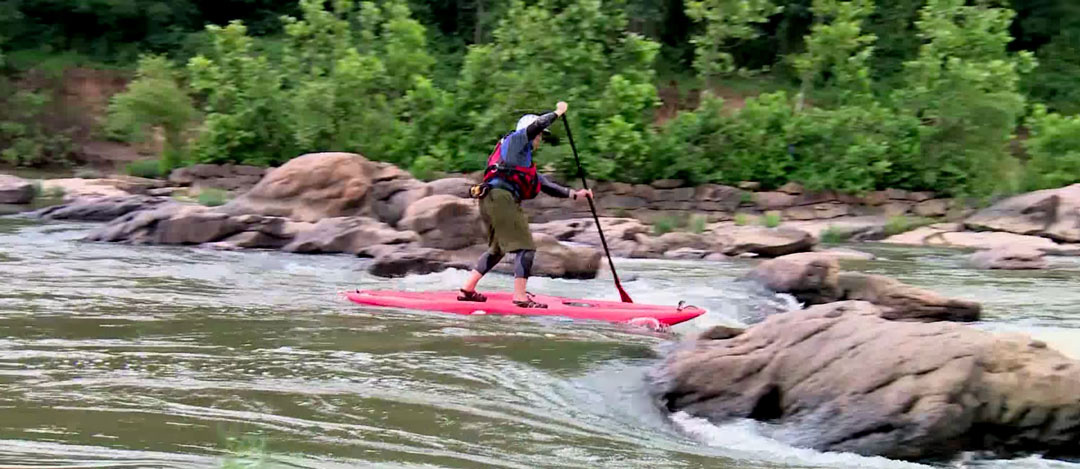
If you do not know which life jacket to use, there are a number of paddle specific models on the market. These life jackets have been designed to be comfortable to wear and do not restrict your movements while you paddle. If you are a strong swimmer, you should look at an inflatable life jacket. The most common inflatable life jacket used by paddle boarders will actually be a belt around the waist which can easily inflate when needed.
The leash is important because it tethers you to the paddleboard. The only time you might not want to wear your leash is when you are paddling whitewater rapids. In other situations, being attached to your board can be very helpful because you will not believe how quickly you can be separated from the board when you fall off.
Know Where To Go
The last rule that you need to know is to understand where you should be paddle boarding. The best places for beginners to stand up paddle board will be sheltered areas. These areas should be away from the wind and waves with a good launching and landing point. You should also look for areas with a minimum amount of boat traffic.
Only experienced stand up paddle boarders should look at heading to the waves and where there is wind. You will also need to be a confident swimmer when doing this because you will have to fight the movement of the water.
There are a number of rules that you need to know when it comes to stand up paddleboarding. These rules will ensure that you are safe and able to stay out on the water for longer.
A Short And Complete History Of Standup Paddling
/0 Comments/in History, Stand Up Paddling News/by adminStandup paddling has a history that is longer than many people assume. The modern paddle board has been designed with recreation in mind, but this was not always the case.
Early standup padding had more practical purposes before it was turned into something for leisure.
Early Standup Paddling
Early standup paddling was practical and generally something that fishermen across the world did. Fishermen would stand on solo vessels and paddle to maneuver the vessel. There are still many fishermen who practice this ancient technique.
History of Stand Up Paddling
The small vessels were created to maneuver through waterways and in the shallow areas of the ocean. The original paddles used were often made of hollowed lengths of wood and helped the fishermen navigate the waves. The use of these standup paddle boats was seen in South America and predates the arrival of the Spanish in the 15th century.
Early Standup Paddling In Europe
While there is a long history of standup paddling in South America and Asia, Europe also contributes to this history. The most famous of the European standup paddling is the gondoliers of Venice. Venice in the 17th century was built almost entirely on the water and uses the canals as a means to travel.
To navigate the canals, there are gondolas steered by the famous gondoliers. At the height of Venice’s popularity, there were an estimated 8000 to 10000 gondoliers paddling their way through the canals. This number has decreased drastically over the years and today there is an estimated 400 gondolas in service. Today, they are mainly used to shuttle tourists through the amazing city, but at one point they were the primary means of transportation in the city.
Standup Paddling For Fun
The early history of standup paddling focused mainly on the practical uses of this. However, there is a long history of standup paddling being used for fun. The Hawaiians were the pioneers of using a standup paddle board purely for the thrill that it provides.
Ancient Hawaiians called themselves keiki o ka’aina which means children of the land. The land provides them with food and materials to build with. The land is also the sibling of the sea and so mankind was seen as a sibling which was born to the same parents at the start of time. As siblings of the sea, Hawaiians of all ages enjoy playing in the water.
The solid evidence of standup paddle boarding by Hawaiians is only 70 years old, but it is commonly agreed on that this was practiced for centuries before the picture. One of the most famous Waikiki boys, Duke Kahanamoku, is said to have used an outrigger paddle to propel his board into the waves of Waikiki.
Hawaii is not only the home to some of the first standup paddle boards for leisure, it is also the home of many modern standup paddle boarding inventions. Many of the accessories for paddle boarding which are used today are believed to have been created by Hawaiian beachboys. One of the most commonly used is the leg leash.
The leg leash connects you to the board and is very helpful in a number of different situations. The leg leash was created by John Ah Choy also known as Pops. Pops was an inventor and is one of the most famous early paddle boarders.
Standup paddling has a very long history and can be dated back centuries. Early standup paddling was generally completed for practical reasons such as fishing or traveling through the canals of Venice. However, it has also been a leisure activity for many people and this was pioneered by the Hawaiians.
SUP Utah
Recent Posts
Ride with the wave.
